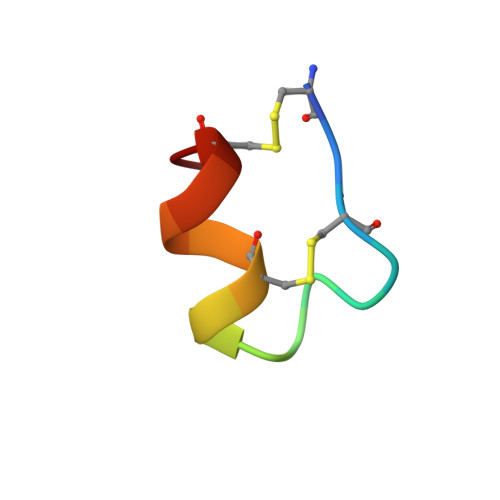Conformational isomerism of endothelin in acidic aqueous media: a quantitative NOESY analysis.
Andersen, N.H., Chen, C.P., Marschner, T.M., Krystek Jr., S.R., Bassolino, D.A.(1992) Biochemistry 31: 1280-1295
- PubMed: 1736987
- DOI: https://doi.org/10.1021/bi00120a003
- Primary Citation of Related Structures:
1EDP - PubMed Abstract:
The conformational features of endothelin-1 (ET-1) in mixed water/ethylene glycol media have been studied by two-dimensional 1H NMR experiments throughout the pH range 3.2-7.2. At pH less than 5 all backbone NH signals can be observed, and NOESY experiments provided a large set of dipolar cross-peaks. Cross-peak intensities from each experiment (different mixing times and H2O versus D2O) were converted to distance constraints using a novel algorithm (program DISCON) for removing spin diffusion effects and thus obtain cross-rates rather than cross-peak intensities. A set of 168 nonstereospecific distance bounds (average experimental precision, +/- 0.38 A) was used in dynamics simulated annealing refinements. Two consensus structural features were found--a reverse turn at Ser5----Asp8 and an alpha-helical stretch from Lys9 to Cys15; however, after constraint-free minimization, structures generated using XPLOR-1.5, CONGEN, and DISCOVER all violated at least 32% of the bounds by more than 0.2 A, which we ascribe to conformational isomerism. When the constraints were modified to reflect subsequent experimental data and to eliminate constraints that could not be obeyed by any single conformer structure, the relaxed structures still violated at least 15% of this more limited and looser set of constraints. Therefore, a modified procedure for constrained dynamics refinement (using XPLOR-2.1), which allows for conformational isomerism outside of the central helical core region, was developed. This "conformer search procedure" produced structures which fell into five tightly defined conformational clusters. The two most populated clusters correspond to a rotation of the 8,9-amide unit. The conformer which we propose as the major contributor at pH 3.2-5.8 was defined to a backbone rmsd of 0.51 A over residues 1----15. An alternative description of the motional averaging in segments of the endothelin structure as extensive randomization rather than rapid interconversion between a small number of discreet conformers was ruled out by an analysis of NH shift-temperature gradients and exchange rates. This analysis suggests that small delta delta/delta T values need not correlate with H-bonding for conformational mixtures. In ET-1 the greatest motional averaging occurs from Ser2 through Ser5 (not in the C-terminus) and may be so extensive as to approximate a flexible random coil population as high as 30%. The C-terminus shows less rapid and less extensive conformational averaging, but no definitive structures for individual conformers could be derived in the absence of stereospecific constraints. The pharmacological implications of the consensus structural features are discussed.
Organizational Affiliation:
Department of Chemistry, University of Washington, Seattle 98195.














